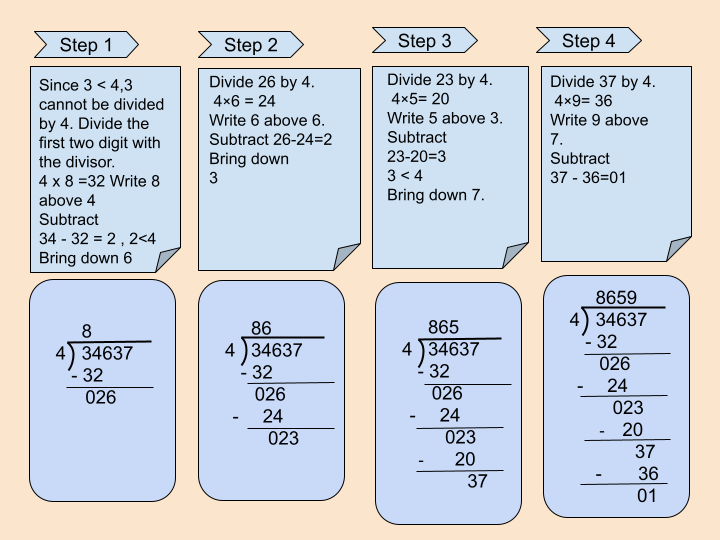Easy Division for Grade 4 [12 Practice Worksheets]
The learning outcomes are as follows:
- Classify the division sums
- Properties of Division
- Evaluate division using the grid method and long division method
- Division by equal sharing, equal grouping, and repeated subtraction
- Division of a 4-digit number by 1, 2 and 3-digit numbers
- Division of a 5-digit number by 1, and 2-digit numbers
- Dividing by 10, 100 or 1,000
-
What are some real-life examples of division?
What Is Division?
Division: Division is one of the four arithmetic operations. Multiplication and division are co-related. The process of distributing a group of things into equal parts is called division.
Dividend: The number that is to be divided is called Dividend.
Divisor: The number by which the dividend is divided is called the Divisor.
Quotient: The results obtained in the division process is called the Quotient.
The symbol used for division is “÷”.

Properties of Division
1. Division by 1: Imagine a zoo keeper putting animals into various enclosures-
Property: Any number divided by 1 is the number itself
-
Example: Ten flamingos were in the enclosure, and the zoo keeper decided to put them all in one big enclosure. Since, they're all together, there are still 10 flamingos in the enclosure
-
Explanation: So, 10 ÷ 1 = 10. Dividing by 1 means the group size remains unchanged.

2. Division by the Same Number (Identity Property)
-
Property: Any number divided by itself equals 1.
-
Example: If you have 9 slices of pizza and 9 friends, then each friend will get exactly 1 slice.
-
Explanation: Therefore, 9 ÷ 9 = 1. A number divided by itself results in one whole unit.

3. Division by Zero: Imagine you have a jar full of candies
-
Property: When 0 is divided by any number, the quotient is 0.
-
Example: Imagine you have 10 candies, but there is nobody to share them with! You can't divide up anything with zero people.
-
Explanation: Because you do not have anyone to share with, you can't divide by zero.

Watch Orchids's video on Properties of Division:
Division As Opposite of Multiplication:
Example :
There are 12 balls and 3 boxes. Arrange 12 balls equally in the 3 boxes.

Answer:
We know that 3 × 4 = 12. So, if 12 balls are divided into three boxes, then each box will contain 4 balls. 12 ÷ 3 = 4.

Division Using Grid Method:
Example :
Divide 96 by 4.
Answer:
Write 96 on the grid and 4 outside the box.

Long Method of Division for 2-digit Numbers:
Example :
Divide 39 by 3.
Answer:

Common Mistakes:
Students generally neglect the place holder of 0.
Example :
404 ÷ 2

The correct way is:

Therefore, 404 ÷ 2 = 202
Try these yourself!
1. 72 ÷ 9 =
2. 77 ÷ 7 =
3. 132 ÷ 4 =
4. 165 ÷ 5 =
5. 96 ÷ 3 =
6. 91 ÷ 7 =
Division by equal sharing, equal grouping, and repeated subtraction
Division by equal sharingDivision by equal sharing is a way to divide the number of items into equal groups. The goal is to make sure that each group gets the same amount. This is often used in real-life situations, like sharing toys or fruits.
Example: Imagine you have 20 toy cars, and you want to share them equally among 5 children.-
Start by giving each child 1 toy car. After 5 children, that’s 5 cars.
-
Keep giving out 1 car to each child until all 20 cars are shared.
-
After distributing all the toy cars, each child gets 4 cars.

So, dividing 20 toy cars by 5 children means each child gets 4 cars.
Division by Equal Grouping
Division by equal grouping is when you start with a certain number of items and want to divide them into equal groups. In this case, you know how many items go in each group and need to figure out how many groups you can make.
Example:
You have 24 toy cars, and you want to make groups with 4 cars in each group.
To divide the cars into groups: Put 4 cars in the first group.
Keep adding 4 cars to each new group until all 24 cars are used up.
Counting the groups:
-
After the first group, you have 4 cars.
-
After the second group, you have 8 cars.
-
After the third group, you have 12 cars.
-
After the fourth group, you have 16 cars.
-
After the fifth group, you have 20 cars.
-
After the sixth group, you have 24 cars.

So, you can make 6 groups of 4 cars each.
Division by repeated subtraction
Division by repeated subtraction is subtraction of the same number more than once up to the number that equals zero. This technique helps you find out how many times a number can be subtracted before it equals to zero. Now, let's consider examples with apples and toy cars.
Example: Division by Repeated Subtraction
You have 24 toy cars, and you want to divide them into groups of 4 cars using repeated subtraction.
Start with 24 toy cars.
Subtract 4 cars at a time:
24 - 4 = 20 cars
20 - 4 = 16 cars
16 - 4 = 12 cars
12 - 4 = 8 cars
8 - 4 = 4 cars
4 - 4 = 0 cars
You subtracted 6 times. So, 24 divided by 4 equals 6. This means you can make 6 groups of 4 toy cars.
Watch Orchids' video on Division:
Division of a 4-digit number by 1, 2 and 3-digit numbers
Dividing a 4-Digit Number by a 1-Digit Number
Example: 2326 divided by 2

Dividend = divisor x quotient + remainder
Divisor 2, quotient 1163, remainder = 0
Dividend = 2 x 1163 + 0 = 2326
Dividing a 4-digit Number by a 2-digit Number
Example: 5,648 ÷ 12
Dividend = divisor x quotient + remainder
Divisor 12, quotient 470, remainder = 8
Dividend = 12 x 470 + 8 = 5648
Dividing a 4-digit Number by a 3-digit Number
Example: 4726 divided by 172

Dividend = divisor x quotient + remainder
Divisor 172, quotient 27, remainder = 82
Dividend = 172 x 27 + 82 = 4726
Division of a 5-digit number by 1, and 2-digit numbers
Dividing a 5-Digit Number by a 1-Digit NumberExample: 34637 divided by 4

Dividend = divisor x quotient + remainder
Divisor 4, quotient = 8659, remainder = 1
Dividend = 4 x 8659 + 1 = 34637
Dividing a 5-Digit Number by a 2-Digit Number
Example: 44368 divided by 23

Dividend = divisor x quotient + remainder
Divisor 23, quotient = 1929, remainder = 1
Dividend = 23 x 1929 + 1 = 44367 + 1 = 44368
Dividing by 10, 100 or 1,000
Dividing by 10When any number is divided by 10, the digit in one's place will be the remainder and the other digits together will be the quotient.
Example: 5,678 divided by 10

When any number is divided by 100, the digits in the tens and ones place will be the remainder and the other digits together will be the quotient.
Example: 9,124 divided by 100

When any number is divided by 1000, the digits in the tens and ones place will be the remainder and the other digits together will be the quotient
Example: 4,321 divided by 1,000
What are some real-life examples of division?
Here are some real-life examples that illustrate the concept of division:
1. Sharing Sweets Among Friends: Imagine you have 24 sweets and want to share them equally among 6 friends. How many sweets will each friend get? (24 divided by 6 equals 4 sweets per friend).

2. Distributing Pizza Slices: You have 8 slices of pizza and 4 people. If each person gets an equal number of slices, how many will each person receive? (8 divided by 4 equals 2 slices per person).
.jpg)





Fun facts:
- If a number is divided by itself then the quotient is 1.
- If a number is divided by 1 then the quotient is the number itself.
-
Division by zero is not possible. It means that we cannot divide a number by 0. In other words, divisor is always a non-zero number.
Summary Division:

Division Quiz: Try it yourself and build confidence!
1. There are 18 cupcakes, and 6 friends want to share them equally. How many cupcakes does each friend get?
A) 2B) 3
C) 4
D) 6
2. A pizza shop has 36 slices of pizza. They want to give each customer 6 slices. How many customers can they serve?
A) 5B) 6
C) 8
D) 9
3. There are 24 crayons, and each box holds 4 crayons. How many boxes are needed?
A) 5B) 6
C) 7
D) 8
4. The farmer has 30 apples and wants to put 5 apples in each basket. How many baskets does he need?
A) 4B) 5
C) 6
D) 8
5. A pack of 45 stickers is split into 9 equal groups. How many stickers are in each group?
A) 3B) 5
C) 7
D) 9
6. There are 35 toys, and each child receives 7 toys. How many children are there?
A) 3B) 4
C) 5
D) 6
Division Practice Worksheets:
Click to download the worksheets for hands-on practice!-
Easy Level Worksheets
-
Intermediate Level Worksheets
-
Advanced Level Worksheets
Explore More Resources:
Check out our other pages to strengthen your concepts.
Orchids' Learning Material:
Click to download the e-bookThings you have learnt!
- Division is an essential math skill that builds a strong foundation for advanced concepts.
- Real-life examples helped demonstrate how division applies to everyday situations.
- Questions, quizzes, and visual aids like images and videos were used to make learning division engaging and fun.
- Keep practicing and exploring new division challenges to strengthen your skills!
Related Links
CBSE Schools In Popular Cities
- CBSE Schools in Bangalore
- CBSE Schools in Mumbai
- CBSE Schools in Pune
- CBSE Schools in Hyderabad
- CBSE Schools in Chennai
- CBSE Schools in Gurgaon
- CBSE Schools in Kolkata
- CBSE Schools in Indore
- CBSE Schools in Sonipat
- CBSE Schools in Delhi
- CBSE Schools in Rohtak
- CBSE Schools in Bhopal
- CBSE Schools in Aurangabad
- CBSE Schools in Jabalpur
- CBSE Schools in Jaipur
- CBSE Schools in Jodhpur
- CBSE Schools in Nagpur
- CBSE Schools in Ahmednagar
- CBSE School In Tumkur











